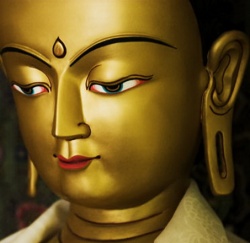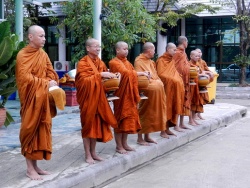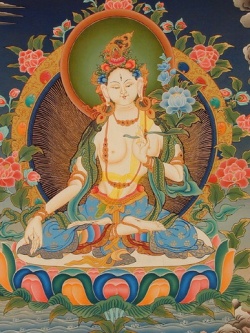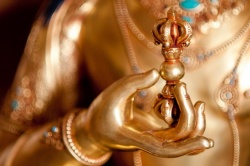Reading Vasubandhu: Pañcaskandhaka-prakaraṇa
This posting is part of an ongoing series on writings by Vasubandhu, the founder of the Yogācāra school of Buddhism. Nothing has happened over the intervening couple of days to make me any more qualified to say anything about this stuff, so please consider this light entertainment and if you notice that I'm completely misunderstanding something, feel free to set me straight. I'm reading this translation and commentary by Stefan Anacker.
Vasubandhu's Pañcaskandhaka-prakaraṇa, "A Discussion of the Five Aggregates," is dense. It packs a complete model of the human personality into a few pages of text and then throws in a method for dealing with all kinds of unpleasantness, and finishes up by describing what happens in deep meditational states. Almost as an afterthought, he ties it together into a complete psychological theory of birth, decrepitude, and death. What's more, the format of the work is not the most accessible to your 21st century dilettante—it's written as an Abhidharma list, and consists entirely of definitions of terms.
And what are views? These views are generally of five kinds: the view of a fixed self in the body, views regarding the permanence or impermanence of the elements constituting personality, false views, adherence to particular views, and adherence to mere rule and ritual.
I read it. Then I did a round of zazen and read it again. Then I discussed it with someone while reading it a third time. Now I'm reading it a fourth time as I'm writing this. I'll certainly have to read it many more times before I run out of new things to find in it, and I have a feeling that a few decades of intensive meditation would help too. Nevertheless, I think I'm getting a picture of what Vasubandhu is saying in it, and the little I am picking up is nothing short of awesomely brilliant. What follows is a re-telling of what I have gotten out of this text so far, in a more familiar format.
The central question in Pañcaskhandhaka-prakaraṇa is "What is this thing we call a 'personality?'"
Vasubandhu's answer starts from the conception of a discrete citta, or consciousness-event. A citta can occur at any level in a human psychophysical entity. For example, a collection of molecules attaching to receptors in your sinuses is a citta, the sensation of smell that arises from that is another citta, the recognition of that smell as "coffee" is another citta, the thought of freshly-ground coffee beans is another citta, "I'd really like a nice cup of fresh coffee" is another citta, and the decision to go make one is yet another citta.
Each citta conditions following cittas, as in the example above where aromatic compounds attaching to receptors resulted in a stream of cittas ending up with a volitional action of brewing a cup of coffee. Furthermore, each citta makes an imprint into a "store-consciousness" or "seed-consciousness," which stores things we call "memories," "tendencies," and "habits." This store-consciousness cannot be directly apprehended; it can only be inferred from its effects (presumably using the method of inference he described in Vāda-vidhi.)
Vasubandhu makes no distinction between what we would call psychological events (e.g. a desire for a cup of coffee) and physical events (e.g. molecules attaching to receptors in the sinuses), beyond placing them in different heaps—the skandhas from the text's title. Regardless of whether a citta occurs in the heap of materiality, sensation, cognition, or volition, they're all cittas, and all work the same way. There's no fundamental difference between a smoker ruining his sense of smell by physically overloading his smell receptors with noxious fumes and a fast-food addict ruining his appreciation of good food by teaching himself that the sensations created by ingesting glucose syrup, salt, and saturated fats are "pleasant." In both cases, we have cittas conditioning new cittas and leaving imprints on the store-consciousness.
Even though the personality consists fundamentally of discrete events that follow and condition each other, we experience an illusion of continuity. This illusion is created by the events occurring as aggregates—the skandhas in the title of the work. So, the near-infinity of cittas occurring in a living body, the huge mass of sensory impressions transmitted through sight, sound, smell, touch, and taste, the streams of cognitional cittas constantly categorizing those impressions, and the streams of volitional cittas created from these impressions and from seeds previously imprinted into the store-consciousness together create an illusion of a continuous personality. Consciousness is nothing more than awareness caused by and of streams of cittas bouncing around a psychophysical entity we call "a person."
As a final flourish in his outline of the human personality, Vasubandhu describes life-force, birth, and decrepitude in terms of his model of ever-flowing streams of cittas. Perhaps it's a failing of mine, but I'm always delighted when someone explains something like this without recourse to supernatural woo:
What is "life-force?" It is, as regards any events taking part in an organism, any continuity, for a certain time, of motivating dispositions which have been projected by past action. And what is "taking part in an organism?" It is any close interrelationship of bodily parts as regards sentient beings. What is "birth?" It is any arising of a stream of motivating dispositions which has not already arisen, as regards any collection of events taking part in an organism. And what is "decrepitude?" It is an alteration in the stream of those like that.
Death, on the other hand, is merely a "cessation not through contemplation"—fundamentally no different from a cessation of a perception of the color blue when the blue object that caused the perception to arise has been removed from the sense-field of the eye.
Having thus established the structure of a "personality," he moves on to the therapeutic implications of his model. He defines a large number of different types of cittas occurring in each of the aggregates, and classifies each of them as beneficial, harmful, or indifferent. He further describes antidotes for each of the harmful cittas or "afflictions." Implicit in this set of definitions is an entire therapeutic method: first, through meditative concentration, developing an awareness of the cittas making up your consciousness-streams. Then, by recognizing which of the afflictions you're most suffering from, identifying the appropriate antidotes. Finally, healing yourself by cultivating the antidotes to these afflictions by conscious volitional action.
Vasubandhu goes on to describe outcomes of this course of "therapy:" as the antidotes gradually leave their marks in the store-consciousness, the afflictions start to wither; this leads to a more balanced and happier state of mind. At the same time, the meditational activity that accomplishes this healing creates deeper meditational states; the activity of peeling away the afflictions will, in itself, lead to various samadhis, culminating in the "attainment of the cessation of cognitions and feelings," when all the skandhas will have emptied and what's left is direct apprehension of reality itself.
This is a therapeutic and spiritual program rolled into one; there is no distinction to be made between the beneficial effects of meditative practice, the volitional action directed at ridding oneself of afflictions, and the Eightfold Path. This is a mighty powerful—and empowering—insight into dealing with unpleasant or difficult stuff. No doctor, guru, or master can ever tell you which afflictions you're suffering from, or magically cure you. Only you can do that. The best a teacher can do is be a sounding-board and a guide, and teach you the meditational techniques and conceptual tools you can use to effect your own healing, whether it's from depression or dukkha.
I really like this way of looking at the personality—for example, it renders the question of whether schizophrenia is a physical ailment caused by a screw-up in brain chemistry or a mental condition caused by childhood traumas (or whatever) completely meaningless: "schizophrenia" is itself an empty label; the "patient" is merely suffering from a variety of afflicted cittas occurring in all of the skandhas. Similarly, it sidesteps the problems sometimes discussed of, say, different types of Zen—in Vasubandhu's model, bompu Zen ("therapeutic" Zen) would be exactly the same as saijojo Zen (the practice of enlightenment). The only difference lies in the state of the personality staring at the wall—do enough bompu Zen, and you will eventually find yourself doing saijojo Zen.
I was also struck by a few things related to the bigger philosophical picture.
Vasubandhu is very emphatic about anatta (the lack of any central, abiding, or unchanging self), listing three different types of afflicted views about it—grasping for a "doer," grasping for an "enjoyer," and grasping for "one central entity." This is in clear opposition to the likes of Patañjali, who posit an unchanging puruṣa, and I don't think he would have had much time for The Zennist's views on the self either. Similarly, a deeply internalized sense of universal causal interconnectedness (paticca-samuppada) and emptiness (śunyatta) pervade his entire model.
On the other hand, the ostensible topic of the text—the five aggregates, or skandhas—seem almost incidental. They're a convenient way to categorize cittas, but they clearly have no ontological existence or independent meaning of their own; cittas influence each other across the skandhas, and the illusion of continuity or an abiding "self" arise from the fact that they occur in streams where preceding cittas influence following ones directly or through the intermediary of the store-consciousness.
I was left wondering about one final thing in Vasubandhu's model. He is quite specific about the particularity and distinctness of cittas; he treats them as something like "atoms" of consciousness. This leads to all kinds of philosophical problems: for example, if a citta is a momentary, atomic event, how can one citta influence another? How, for example, can a citta in the skandha of motivational dispositions affect cittas in the skandha of cognition? Vasubandhu's seed-consciousness is clearly at least partly posited to answer this question; however, in his discussion he does appear to state that cittas also influence each other directly.
In my naive reading of his text, his cittas appear to behave in a more dynamic manner. To continue the physics analogy, they look more like the probability distributions of quantum physics than the hard, indivisible atoms of classical atomic theory. I wonder if this hard and distinct nature of cittas is really essential to Vasubandhu's philosophy, or if it's a conceptual category that he picked up from his environment? After all, discussions about the atomic nature of the universe were very much in vogue at the time, and (or so I understand) an accepted "fact" in Abhidharma orthodoxy.
Philosophers East and West have had a hard time dealing with continuities. A few hundred years previously, Zeno of Elea formulated his famous paradoxes, proving that Achilles can never catch a tortoise, and an arrow can never reach its mark. Vasubandhu's "atomic" cittas are strangely reminiscent of the problems Zeno was dealing with, and, at least on the surface, could be resolved with the same expedient—by describing the series of cittas as a continuum of "fuzzy" quanta rather than "distinct" atoms. As far as I can tell, this modification would have no serious repercussions in the rest of his model.
[The next text in the collection I'm reading is titled Karma-siddhi-prakaraṇa, or "A Discussion for the Demonstration of Action." Stefan Anacker's introduction and notes refer repeatedly to it, and apparently it develops further some of the ideas introduced in Pañcaskandhaka-prakaraṇa. I've given it a quick glance, and it appears to be an even tougher nut to crack, so it might be a while before I'm able to write about it. I have a feeling that the little book I bought will be keeping me busy for a quite a long time—there's more gold in it than I will be able to mine in years.




